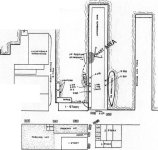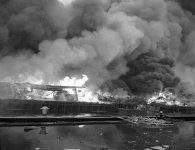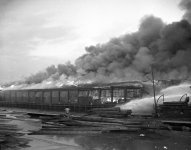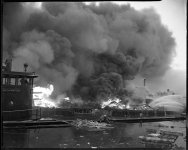- Joined
- Oct 18, 2022
- Messages
- 356
Shortly after 1500hrs on December 3, 1956 staff working in the pierhouse of the Lukenbach Steamship Co 35th Street Pier facility in Brooklyn noticed that a large consignment (26,350lbs) of foam rubber scrap awaiting shipment had caught fire which was quickly growing out of control. The first report of the fire reached Brooklyn Central Office at 1516hrs, which then dispatched several companies to the scene including Engine 228 and Battalion 25. Acting Lt. Kraemer on E228 called in a second alarm shortly after arriving on the North side of the pier and finding the fire seated some 750ft from landside and rapidly spreading throughout the densely packed warehouse. Engine 223, fireboat Fire Fighter, arrived from her station at the foot of 39th St within minutes and began operations as the third, fourth and fifth alarms were rung out roughly 10 minutes apart from each other. Battalion Chief Bahr arrived onscene and quickly ordered the Fire Fighter to shift ahead roughly 200ft closer to shore and link up with E278 to work on containing the out of control fire to the water side the structure and away from a partially loaded freighter on the opposite side of the pier.

Arriving units were still being staged and Fire Fighter was just beginning to send water back topside when the fire reached a 37,000lb shipment of blasting caps destined for California mine and set off an enormous explosion that sent a shrapnel-filled blast wave through the immediate area along with a shockwave strong enough to break windows on every building in a 3-block radius. Though several dozen fire fighters were injured by the blast, there were miraculously no fatalities to the first responders. The same could not be said for the crowd of onlookers watching from the adjacent pier and exposed to the full force of the blast and shrapnel wave; 10 were killed. In the immediate aftermath of the blast, onscene commanders tried to reestablish contact with their units, many assuming the worst for those last known to be in, on and around the pier house itself. The two closest units, E278 and Fire Fighter, were both damaged by the blast and their members all experienced various levels of injury but were soon back in action albeit in a reduced capacity.
In addition to the main fire now consuming the entire pier, new fires in the immediate and surrounding area set off by flaming debris and embers began to be reported, along with reports of hundreds of civilian injuries from glass shards or debris began to join the already-long list of injured members and civilians onsite. The first of two Borough Calls were dispatched by the Brooklyn Central Office as well as a full response from the Marine Division to help combat the fire with the pier now fully involved.




Marine Division units and Coast Guard Cutters worked together to combat the enormous blaze from the harbor side of the while landside units set up streams to keep the fires from spreading further than the pier foot, while intrepid commercial tugboat crews darted in and out of the slips to remove barges and other vessels from the fire area. The Borough Call response continued through the rest of the afternoon and evening, and by nightfall the blaze had been largely contained to the shattered pier itself and relief and containment operations commenced. By dawn on December 4th crews were dousing the last of the hotspots on the totally destroyed pier and taking stock of the previous days events.
Later dubbed "The Miracle on 35th Street" by the comparatively low loss of life among civilians and firefighters, the fire and blast nevertheless caused 250 injuries and killed 10 people in the surrounding area. Investigations into the fire and subsequent blast led to the imposition of new requirements for pier facilities in New York Harbor, specifically in regard to fire prevention and suppression equipment and cargo handling and segregation practices. While certainly effective in preventing another occurrence like the fire at the 35th Street Pier, the regulations also came at a time when most Steamship Companies could ill afford additional expenses in their port operations, which along with containerization and foreign competition lead to a prolonged period of pier and port abandonment in New York Harbor.

 www.flickr.com
www.flickr.com

Arriving units were still being staged and Fire Fighter was just beginning to send water back topside when the fire reached a 37,000lb shipment of blasting caps destined for California mine and set off an enormous explosion that sent a shrapnel-filled blast wave through the immediate area along with a shockwave strong enough to break windows on every building in a 3-block radius. Though several dozen fire fighters were injured by the blast, there were miraculously no fatalities to the first responders. The same could not be said for the crowd of onlookers watching from the adjacent pier and exposed to the full force of the blast and shrapnel wave; 10 were killed. In the immediate aftermath of the blast, onscene commanders tried to reestablish contact with their units, many assuming the worst for those last known to be in, on and around the pier house itself. The two closest units, E278 and Fire Fighter, were both damaged by the blast and their members all experienced various levels of injury but were soon back in action albeit in a reduced capacity.
In addition to the main fire now consuming the entire pier, new fires in the immediate and surrounding area set off by flaming debris and embers began to be reported, along with reports of hundreds of civilian injuries from glass shards or debris began to join the already-long list of injured members and civilians onsite. The first of two Borough Calls were dispatched by the Brooklyn Central Office as well as a full response from the Marine Division to help combat the fire with the pier now fully involved.




Marine Division units and Coast Guard Cutters worked together to combat the enormous blaze from the harbor side of the while landside units set up streams to keep the fires from spreading further than the pier foot, while intrepid commercial tugboat crews darted in and out of the slips to remove barges and other vessels from the fire area. The Borough Call response continued through the rest of the afternoon and evening, and by nightfall the blaze had been largely contained to the shattered pier itself and relief and containment operations commenced. By dawn on December 4th crews were dousing the last of the hotspots on the totally destroyed pier and taking stock of the previous days events.
Later dubbed "The Miracle on 35th Street" by the comparatively low loss of life among civilians and firefighters, the fire and blast nevertheless caused 250 injuries and killed 10 people in the surrounding area. Investigations into the fire and subsequent blast led to the imposition of new requirements for pier facilities in New York Harbor, specifically in regard to fire prevention and suppression equipment and cargo handling and segregation practices. While certainly effective in preventing another occurrence like the fire at the 35th Street Pier, the regulations also came at a time when most Steamship Companies could ill afford additional expenses in their port operations, which along with containerization and foreign competition lead to a prolonged period of pier and port abandonment in New York Harbor.

2015-12-03ThrowbackThursday - the 1956 Bush Terminal Explosion
This week’s Throwback Thursday photos are from December 3, 1956, when an explosion at the Bush Terminal occurred at the Luckenbach Steamship Co., Inc. pier at 35th Street in Sunset Park, Brooklyn, New York. The blast killed 10 people and injured 270. It resulted in "major destruction" within a...
